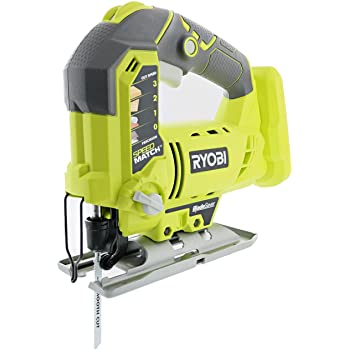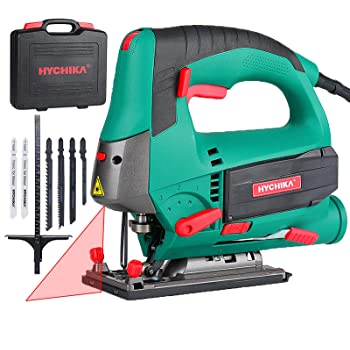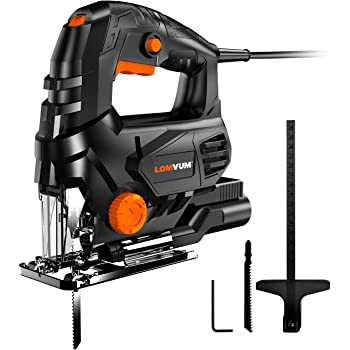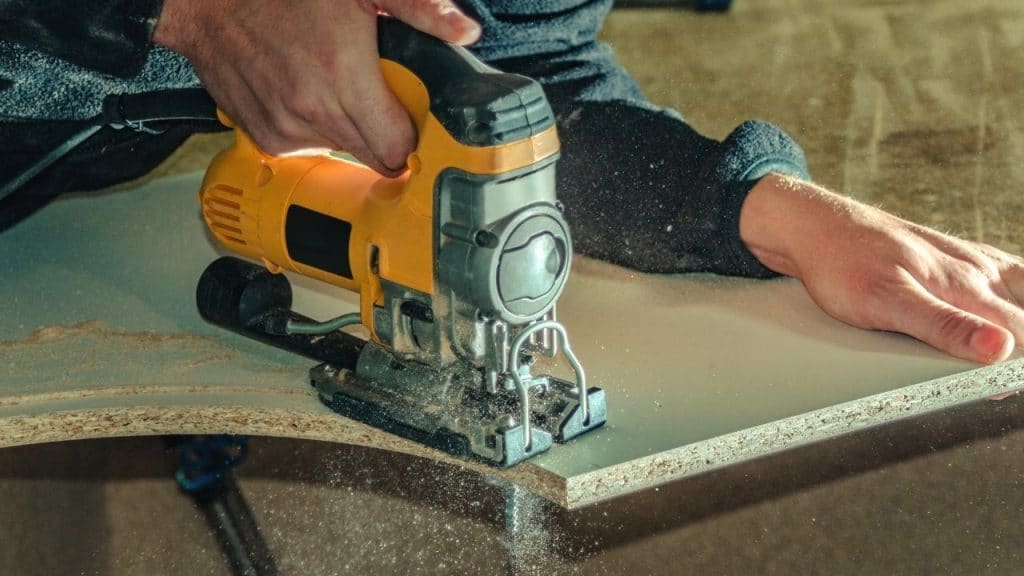
Curved cuts are a hallmark of quality woodworking, and a jigsaw is the best tool for making them. In this article, we will take a look at 10 of the best jigsaws for cutting curves.
We’ll consider features such as blade type, variable speed, and keyless blade clamping to help you choose the right saw for your needs.
Jigsaw Comparison Table
[table id=10 responsive=scroll /]
Best Jigsaw for Cutting Curves in 2022 – Our Top 10 Picks
1. Bosch JS470E

The first best jigsaw for cutting curves on our list the Bosch JS470E. One of our favorite things about the Bosch JS470E is its user-oriented design, making it an extremely convenient jigsaw to use.
The tool less blade change system allows you to use the blade ejection lever for quick insertion, without having to touch the hot blade.
It also features 4 orbital action settings, a variable speed dial and low vibrancy for extra precision. In addition, this Bosch jigsaw comes with an ambidextrous lock on button that will help you work more steadily and comfortably.
The one downside is you will not get any laser guide, which should have been included considering its price point. This could make your job much harder. Their repair services aren’t the best either.
Pros
- Convenient tool less blade change
- Low vibrancy for precision
- Ambidextrous lock on button
Cons
- No laser guides
- Poor repair services
2. DEWALT DCS331B

The DEWALT DCS331B is an excellent contender on this list for a reason, and a great option if you’re looking for a cordless jigsaw. Undoubtedly, this will make your workspace more minimalist and easier to work in.
The jigsaw comes with a keyless blade change to enhance your convenience and user experience. It also features 4 orbital actions and a blower to easily clear sawdust.
Moreover, the battery and charger for this jigsaw are sold separately. This means you can easily find a replacement whenever you need to.
One thing to note is its relatively short warranty, so you should check the tool before the time runs out. Some customers have also reported receiving used products or tools that have been tampered with.
Pros
- Keyless blade change
- 4 orbital actions
- Blower to clear sawdust
Cons
- Short warranty
- May receive used products
3. Ryobi One+ P5231

We say that the Ryobi One+ P5231 is the best jigsaw for cutting curves because it is affordable but very high quality. Perfect for those wanting a quick option that still delivers an excellent performance.
The 4 orbital settings can be adjusted to give you both straight or curved cuts into wood and metal. Meanwhile, the built-in dust blower ensures you have a clean vision by blowing any debris away.
Not only that, this jigsaw also comes with LED lighting to illuminate your project, while the trigger lock system lets you focus only on the cuts.
It does have several drawbacks, including how difficult it is to remove and change the battery pack. The lock button also jams quite easily, which might cause locked angles and blades.
Pros
- Affordable jigsaw
- Built-in dust blower
- LED lighting
- Trigger lock system
Cons
- Hard to remove battery
- Fragile lock button
4. BLACK+DECKER BDEJS300C

For over a century, Black+Decker has established itself as one of the world’s best manufacturing brands, and their jigsaw is no exception.
The BDEJS300C is a small 4.5-amp model that is very affordable, perfect for small projects and DIYers.
Its tiny design packs a variable speed of up to 3,000 SPM that cuts through wood, metal and plastic. Its tool-free blade changes and adjustable shoe also make it much more convenient.
Moreover, we love the dust blower and improved wire guard that ensure clear visibility. This also gives you more accuracy and lets you work on intricate pieces too.
Unfortunately, you do have to be careful when buying online as you may receive faulty or incomplete products.
Pros
- Ideal for small projects
- 3,000 SPM variable speeds
- Tool-free blade change
- Dust blower and wire guard
Cons
- Faulty products
- Poor quality control
5. Skil JS314901

Another high-quality jigsaw to consider is the Skil JS314901, which comes with 4 orbital functions for a variety of applications and materials.
You can control the variable speed using a 2-finger trigger, while the shoe bevel is adjustable without any tools for angled cutting.
You can also change the blade without using additional tools. What’s more, the bright halo light provides 10x illumination than the standard LED too!
On the downside, this Skil jigsaw isn’t very accurate so it may not be the best choice for intricate and precise cuts. Despite its 6 amps rating, customers have also claimed that it is not as strong in performance.
Pros
- Accurate variable speed control
- Tool-free blade change
- Extra bright illumination
Cons
- Not very accurate
- Not the strongest
6. TECCPO TAJS01P

The TECCPO TAJS01P features a 6.5-amp copper motor that can give you up to 3,000 SPM in 6 different speeds.
This versatility lets you work with a variety of materials, from wood and metals to PVC tubes. It also comes with a laser guide and scale ruler for world-class precision! Not to mention the dust blower to keep your working environment pristine clean too.
However, some customers report that they do not receive the full package and often miss components like the case and cord. It also does not boast a heavy-duty quality, which makes it less suitable for larger projects.
Pros
- 6 variable speeds
- Laser guide and scale ruler
- Dust blower
Cons
- Incomplete package
- Not heavy-duty quality
7. HYCHIKA JS-100C

When trying to find the best jigsaw for cutting curves, you should not miss out the HYCHIKA JS-100C. It comes with 6 variable speeds and 3,000 SPM to cut through anything, from wood and metal to aluminum and steel.
Not only that, it also includes 6 different blades to suit a variety of materials!
The jigsaw itself has 4 orbital settings, a laser guide and scale ruler. Additionally, there is a quick release chuck and front dust blower, as well as a non-slip handle for comfortable use.
This jigsaw may not be the most durable you can find but will often do the job. Its laser also doesn’t shine straight sometimes, which could be a problem for some.
Pros
- Includes 6 blades
- Quick release chuck
- Non-slip handle
Cons
- Not durable
- Lasers not straight
8. WEN 33606

The WEN 33606 is worth a look, if only because it is extremely affordable yet well-built. In addition to a 4-position orbital setting, the 6.6-amp motor delivers variable speeds of up to 3,330 strokes per minute.
For accuracy, there is a laser guide, LED light and front-mounted dust blower. Not to mention the lock-on trigger switch and beveling footplate. You might also love that it includes a two-year warranty!
Despite that, there are many who claim to receive defective units. The product is also not the most durable, so this is something to consider.
Pros
- 6.6-amp motor
- 4 orbital settings
- Accuracy features
Cons
- Defective units
- Not durable
9. Hammerhead HAJS048

You might also want to check out the Hammerhead HAJS048 for a versatile and long-lasting unit to complete your power tool house. This corded jigsaw is powerful and can deliver up to 3,000 SPM to cut through all sorts of materials.
With 4 orbital actions and a variable speed control, you can tackle any kind of project too. Plus, it features a brake function to help you create a precise finish. Additionally, this jigsaw comes with a dust port that’s attached to a vacuum.
Meanwhile, the tool-free blade change system lets you replace T-shank blades in no time. If we had to name one downside of the Hammerhead jigsaw, it would be the lack of a user’s manual.
Pros
- Versatile and long lasting
- Brake function for precise finish
- Vacuum-connected dust port
Cons
- No user manual
10. Lomvum WD40280

Finally, let’s not forget the Lomvum WD40280! This affordable jigsaw is a great choice for any personal woodworking projects. It comes with 5 variable speeds and tool-free blade replacement system.
However, you can only use T-blade with this. You can adjust the base plate up to 45-degrees for bevel cutting. The Lomvum WD40280 also features a dust port so you can easily clean any sawdust.
Unfortunately, the blade guard isn’t as well-built as we would like. This could be something to consider before buying.
Pros
- 5 variable speeds
- Tool-free T-blade replacement
- 45-degree bevel cutting
Cons
- Only supports T-blade
- Flimsy blade guard
How to Choose the Right Jigsaw – The Beginner’s Guide

Here are 7 important things you should consider when buying a jigsaw for cutting curves.
1. Orbital Action
Jigsaws with an orbital action are usually better than the standard ones, as the blade can move in an elliptical manner. As opposed to a rigid motion that only goes upwards and downwards, this will help minimize the wear on the blade.
Because the chattering decreases, your blade will be much more durable. Additionally, the angle can be adjusted depending on the material. It also produces smoother results.
Also read: Scroll Saw vs. Jigsaw: Which is Better for You?
2. Variable Speeds
When looking for the best jigsaw for cutting curves, you should find ones that support variable speeds. While this feature is not essential for woodworking, it can do wonders if you will be cutting metals.
Slowing the speed will also help with detailed curved cuts as it gives your more control. While variable speed may not be necessary for everyone, it could be something that you want.
3. Motor Power
Higher quality jigsaws will come with more powerful motors. This means you can enjoy more cutting power for larger projects.
While some of the best motors have a rating of 6.5 to 7 amps, you can find ones with 5 amps or lower.
4. Depth of Cut
Another aspect to look at is the depth of cut, which is usually 2 inches for wood and ½ inch for metals.
You can find some models with a deeper cut, but it doesn’t always mean better. This is because blades that cut deeper are much easier to bend and break.
With deeper blades, we recommend not cutting directly into the line. Leave a little gap and simply use a drum sander afterwards. This will help you make accurately angled cuts, even if they are deeper.
5. Corded vs. Cordless
Corded jigsaws are the conventional model and usually more powerful. I still recommend getting this one if you are planning to only buy one jigsaw.
The cordless variety is much more convenient to use and easily portable. However, its battery performance is still limited.
6. Laser guideline
It’s also worth considering buying a jigsaw that has a laser guideline. The laser on the saw will emit a red cutting line which you can use to guide your cuts.
It will help you make more accurate cuts with your jigsaw. Again, this is not essential by all means, but could be helpful to have.
7. Price
When choosing the right jigsaw for yourself, don’t forget to consider your personal budget. While it’s important to prioritize build quality and durability, try not to spend more than you can.
Remember that it is ultimately the person who creates a woodwork and not the tool. Of course, this doesn’t mean that you should go for the cheapest jigsaw you can find.
Conclusion
Just like buying any other power tool, you can find the best jigsaw for cutting curves if you know what to look for.
This will be an investment for your woodworking armory, but make sure to choose a durable one. Therefore, it can be helpful to read customer reviews too. Good luck!
FAQ
1) Can you cut curves with a jigsaw?
Yes, you can cut curves with a jigsaw. Jigsaws are best for making curved cuts because they have an adjustable foot that allows them to follow the contour of your workpiece.
However, it is important to choose the right blade type and material thickness when cutting curves on a jigsaw so that your saw doesn’t overheat or bind up on the blade.
For best results, use a fine-tooth blade when cutting curves in softwood and a coarse-tooth blade for hardwoods like oak or maple. Also, make sure to use an appropriate feed speed so that your saw doesn’t get too hot from friction caused by the blade rubbing against the material.
2) How do you cut curves with a jigsaw?
There are two ways to cut curves with a jigsaw: freehand and using a template.
Freehand Curves: When cutting curves freehand, it is important to keep the saw blade perpendicular to the workpiece. This can be done by tilting the saw base in the direction of the curve while keeping the blade as close to 90 degrees as possible.
If you are right-handed and making a counterclockwise curve, tilt your saw base to the right. If left-handed or clockwise curves, tilt it leftward. It’s best practice for both types of curves not only because this makes it easier to keep the blade perpendicular to the workpiece, but because it allows you to use your body weight to help push the saw through the material.
Template Curves: When using a template for cutting curves, you first need to make or purchase a template that is the same shape as the curve you want to cut. The best way to do this is by tracing the curve onto a piece of cardboard and then cutting out the shape with scissors.
Once you have your template, place it on your workpiece and secure it in place with clamps or tape. Then, use a sharp blade to cut along the edge of the template. This will give you a perfectly curved cut every time.
3) Can you cut a circle with a jigsaw?
Yes, you can cut circles with a jigsaw. For best results, use an appropriate blade for the material thickness and feed speed that will not cause your saw to overheat from friction caused by rubbing against the workpiece.
4) What size jigsaw blade do I need?
The best blade sizes for a jigsaw are:
- Fine tooth blades: best for hardwoods and cutting curves.
- Coarse tooth blades: best for softwoods and making straight cuts.
- Medium tooth blades: best all-around option, good at both curved and straight cuts.
- T-shank blades: best for thicker materials or metal cutting.
- U-shank blades: best for thinner materials.
If you’re not sure what blade size to use, it is always best to start with the smallest size and work your way up if needed. This will help prevent the blade from overheating while cutting into thicker materials like plywood or MDF board.